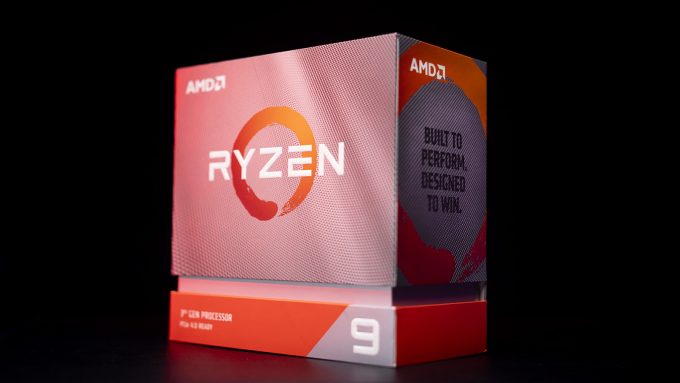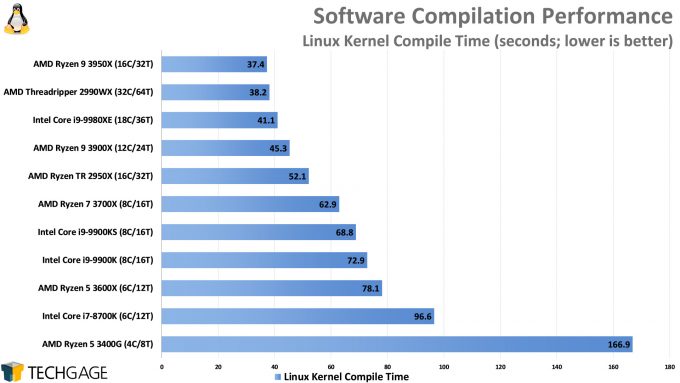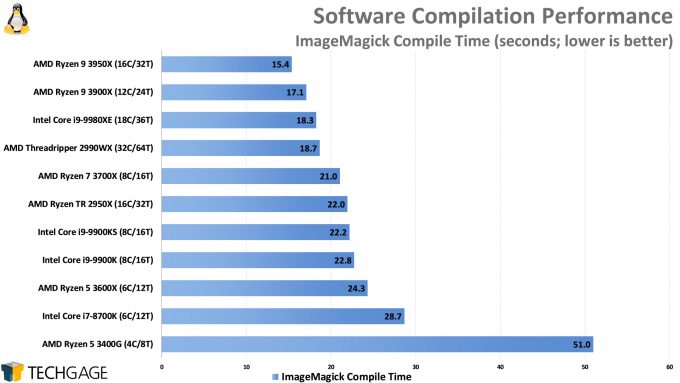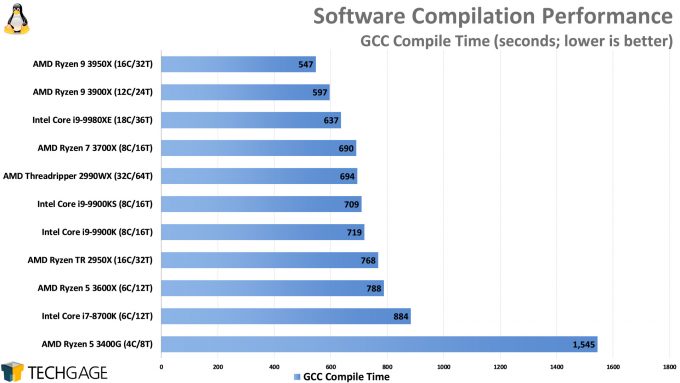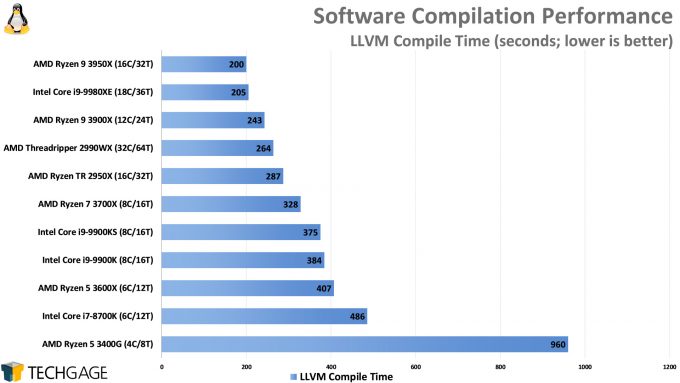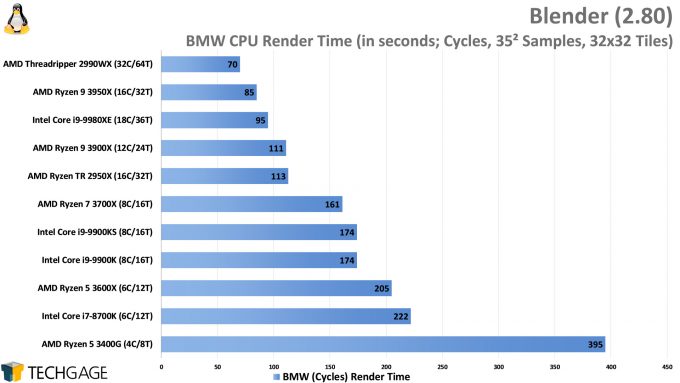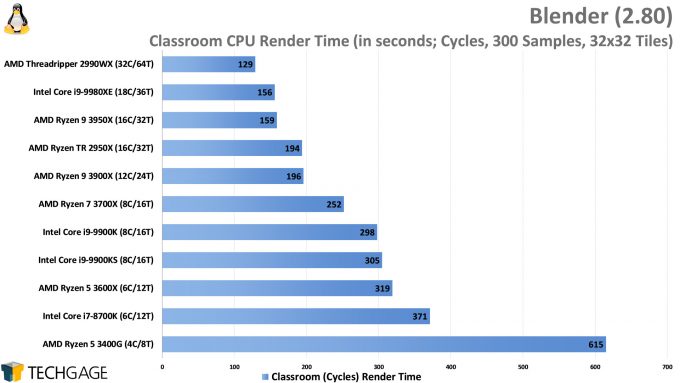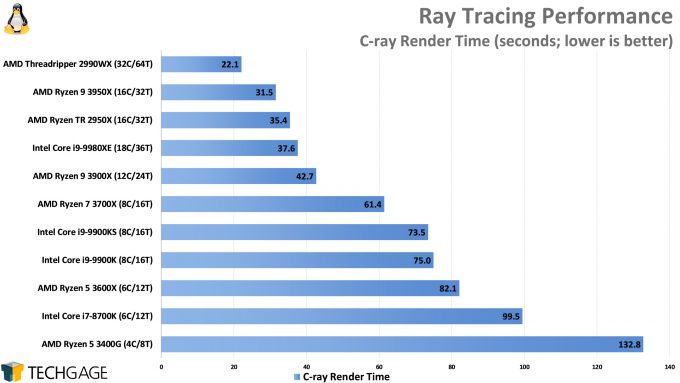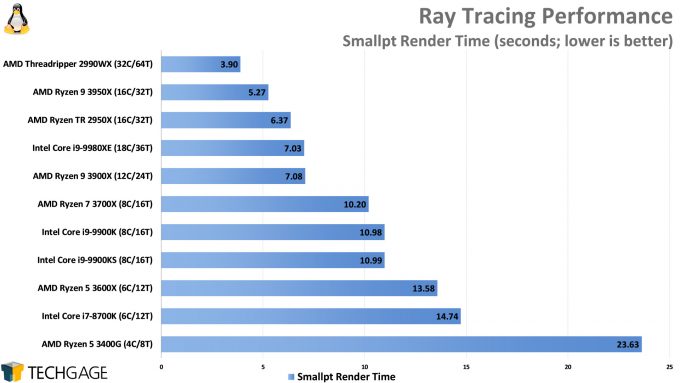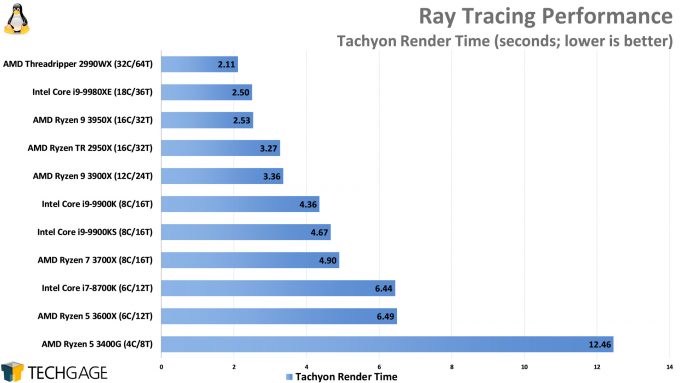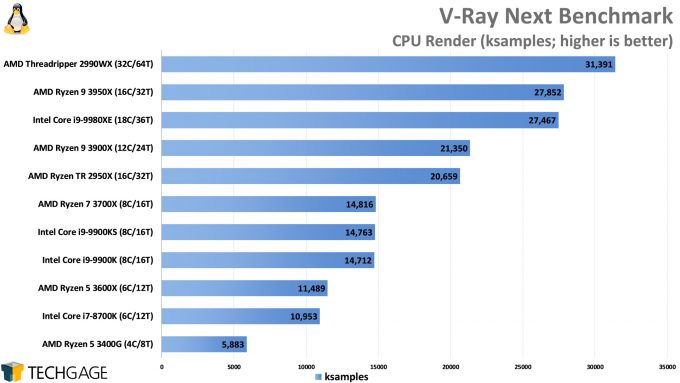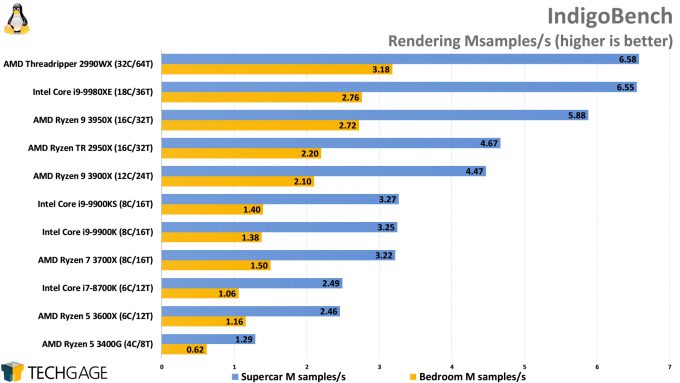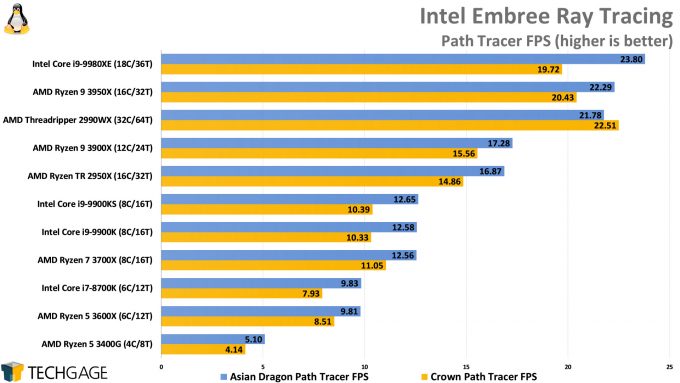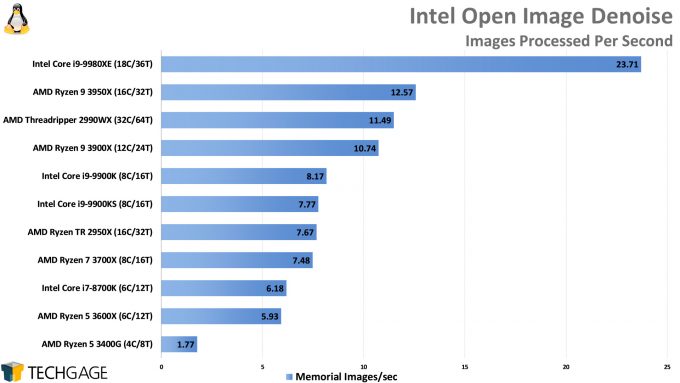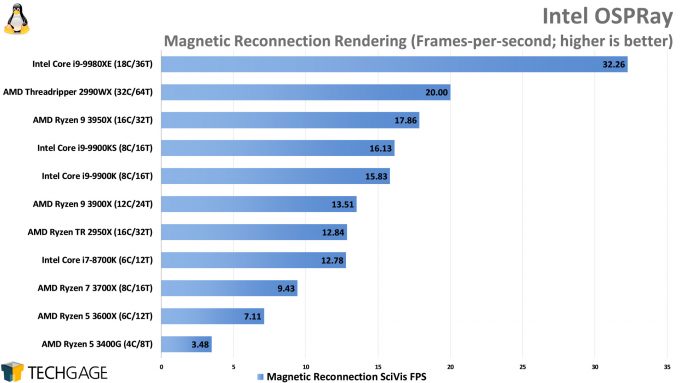- Qualcomm Launches Snapdragon 4 Gen 2 Mobile Platform
- AMD Launches Ryzen PRO 7000 Series Mobile & Desktop Platform
- Intel Launches Sleek Single-Slot Arc Pro A60 Workstation Graphics Card
- NVIDIA Announces Latest Ada Lovelace Additions: GeForce RTX 4060 Ti & RTX 4060
- Maxon Redshift With AMD Radeon GPU Rendering Support Now Available
A Linux Performance Look At AMD’s 16-core Ryzen 9 3950X

With so many CPUs hitting the market this month, it was time to both retest our collection of chips and update our tests. In this article, we’re going to be covering a bunch of workloads in Linux, ranging from compiling to rendering, compute to encryption. AMD’s new 16-core Ryzen 9 3950X joins ten other processors, so let’s see how it stacks up.
Page 1 – AMD’s Ryzen 9 3950X in Linux; Compiling & Rendering Performance
After posting our quick look at the performance of AMD’s new 16-core Ryzen 9 3950X in Windows last week, it quickly became obvious that the rest of our testing was going to be a painfully slow process due to the sheer number of tests that needed doing. With our Linux suite requiring about one-fourth the time to run as the Windows one, and the fact that we had a bulk of the testing done already, it made sense to sideline the rest of the Windows testing until the Linux testing was done. And here we are.
With this article completed, we’re going to return to wrap-up our Windows testing. We’ll then be circling back to Linux soon after to throw new Intel Core X-series and AMD Ryzen Threadripper chips at the test gauntlet.
We’ve expanded our Linux test suite since the last CPU performance review. Every scenario, from compiling to rendering, has been expanded to help us get a fuller look at performance overall. Not all workloads are built alike, and the same can be said about the CPUs themselves. It’s never safe to take the opinion of a single test and expect everything to scale the same way.
AMD’s Ryzen 9 3950X is the first mid-range desktop processor to offer sixteen cores, something that comes at a price-point that definitely doesn’t feel mid-range: $749. With the last generation, both AMD and Intel offered no larger than an eight-core chip in their respective mid-range lineups. AMD shook things up this generation with the release of the 12-core Ryzen 9 3900X in the summer. We’ve known about the 3950X since then, so to say that it’s been a long time coming would be an understatement.
When the first Zen 2 chips released, their Linux experience left a lot to be desired. The popular systemd service manager failed to boot until a workaround patch was released. On Windows, Destiny 2 fans on Zen 2 fell victim to the same bug. Fortunately, that was many months ago, and with the most up-to-date AGESA firmware, issues like those are hopefully a thing of the past.
Here’s AMD’s current Ryzen lineup:
| AMD’s Ryzen & Ryzen Threadripper Lineup | ||||||
| Cores | Clock (Turbo) | L2+L3 | Memory | TDP | Price | |
| Threadripper WX-series | ||||||
| 3970X | 32 (64T) | 3.7 GHz (4.5) | 144MB | Quad | 280W | $1999 |
| 3960X | 24 (48T) | 3.8 GHz (4.5) | 140MB | Quad | 280W | $1399 |
| 2990WX | 32 (64T) | 3.0 GHz (4.2) | 16+64MB | Quad | 250W | $1799 |
| 2970WX | 24 (48T) | 3.0 GHz (4.2) | 12+64MB | Quad | 250W | $1299 |
| Threadripper X-series | ||||||
| 2950X | 16 (32T) | 3.5 GHz (4.4) | 8+32MB | Quad | 180W | $899 |
| 2920X | 12 (24T) | 3.5 GHz (4.3) | 6+32MB | Quad | 180W | $649 |
| Ryzen 9 | ||||||
| R9 3950X | 16 (32T) | 3.5 GHz (4.7) | 72MB | Dual | 105W | $749 |
| R9 3900X | 12 (24T) | 3.8 GHz (4.6) | 70MB | Dual | 105W | $499 |
| Ryzen 7 | ||||||
| R7 3800X | 8 (16T) | 3.9 GHz (4.5) | 36MB | Dual | 95W | $399 |
| R7 3700X | 8 (16T) | 3.6 GHz (4.4) | 36MB | Dual | 65W | $329 |
| Ryzen 5 | ||||||
| R5 3600X | 6 (12T) | 3.8 GHz (4.4) | 35MB | Dual | 95W | $249 |
| R5 3600 | 6 (12T) | 3.6 GHz (4.2) | 35MB | Dual | 65W | $199 |
| Ryzen w/ Radeon Vega Graphics | ||||||
| R5 3400G | 4 (8T) | 3.7 GHz (4.2) | 0.5+4MB | Dual | 65W | $149 |
| R3 3200G | 4 (4T) | 3.6 GHz (4.0) | 0.5+4MB | Dual | 65W | $99 |
Part of AMD’s modus operandi has been to deliver desktop and server processors that cram more value inside than the competition. At a time when quad-cores were standard fare, AMD released its (true) eight-core Ryzen 7 1800X. With those eight cores, gamers could start to multi-task more efficiently than before. With the Threadripper 2 launch, AMD proved that it’s not afraid to hit Intel where it really hurts, and sprinkle cores everywhere.
Things began to accelerate quite a bit last summer. Threadripper second-gen came along, and while the top-end options were not without issues, the 32-core part sure was mind-blowing at the time of its release, offering almost twice the number of cores of the Intel Core i9-9980XE. Unfortunately, Intel doesn’t have any quick answers to these many-core chips from AMD, as its Core i9-10980XE will still peak with 18 cores.
Those wanting a huge bang-for-the-buck but don’t want to go with the 3950X would do well to consider losing four cores and moving to the 3900X. Who should get the 3950X instead, are creators who can take advantage of the entire chip. Simple multi-tasking won’t pull that off, but rendering, encoding, virtual machines, and content design will be happy with the extra cores.
Because of its target platform, the 3950X has a dual-channel memory controller, which might rub those who demand huge bandwidth the wrong way. This is one of the definite trade-offs to going with this platform over the higher-end AMD X399 or Intel X299 platforms. Not all workloads are hugely dependent on memory, but you should definitely figure out if yours is before you slap down some coin.
Performance Testing CPUs Under Linux
| Techgage Workstation Test System(s) | |
| Processors | AMD Ryzen Threadripper 2990WX (32C/64T; 3.0 GHz) AMD Ryzen Threadripper 2950X (16C/32T; 3.5 GHz) AMD Ryzen 9 3950X (12C/24T; 3.8GHz) AMD Ryzen 9 3900X (12C/24T; 3.8GHz) AMD Ryzen 7 3700X (8C/16C; 3.6GHz) AMD Ryzen 5 3600X (6C/12C; 3.8 GHz) AMD Ryzen 5 3400G (4C/8T; 3.7 GHz) Intel Core i9-9980XE (18C/36T; 3.0GHz) Intel Core i9-9900KS (8C/16T; 4.0 GHz) Intel Core i9-9900K (8C/16T; 3.6 GHz) Intel Core i9-8700K (8C/16T; 3.7 GHz) |
| Motherboards | AMD X399: MSI MEG CREATION AMD X570: Aorus X570 MASTER AMD B450: Aorus B450 Pro WiFi Intel Z390: ASUS ROG STRIX Z390-E GAMING Intel X299: ASUS ROG STRIX X299-E GAMING |
| Cooling | AMD X399: Enermax LIQTECH TR4 240mm AMD X570: Corsair Hydro H100i PRO AMD B450: AMD Wraith Spire Intel Z390: Corsair Hydro H100i V2 Intel X299: NZXT Kraken X62 |
| Chassis | AMD X399: Cooler Master MasterCase H500P Mesh AMD X570: Fractal Design Define C AMD B450: Enermax Equilence Intel Z390: NZXT S340 Elite Intel X299: Corsair Carbide 600C |
| Graphics | NVIDIA TITAN RTX |
| Memory | G.SKILL Flare X (F4-3200C14-8GFX) 4x8GB; DDR4-3200 14-14-14 |
| Et cetera | Ubuntu 19.10 (5.3.0-23 kernel) |
Our Linux configuration is simple overall. We’re using the latest version of Ubuntu (19.10) for our testing here, updated as much as possible. It includes the 5.3 kernel and GCC 9.2.1. A lot of our tests are run with the help of Phoronix Test Suite, with tests locked to a specific version to generate reliable data. We don’t do any real OS configuration outside of disabling sleep, and enforcing the performance power profile.
As for platform configurations, all of them have been tested with the same 32GB kit of DDR4-3200 memory (we had a stick seemingly die after testing, so… RIP!), and outside of enabling the memory spec, the motherboard UEFIs are left stock. An exception to that rule is with ASUS motherboards on Intel platforms. On those, Multi-Core Enhancement is disabled to prevent a vendor-specific automatic overclock. MCE is not the same as regular Intel Turbo, and it needs to be off for true apples-to-apples results. The tested AMD boards do not have the same vendor-specific automatic overclocking feature.
Beyond all of that, all of the platforms have been updated to their latest UEFI, which for AMD means the latest AGESA release is reflected. No special patches are installed for the sake of security mitigation; we simply take the updates that Ubuntu provides us by default.
Compiling Performance
To kick things off, we have one of the easiest conclusions to make: the 3950X is an absolute beast with software compiling. It even manages to beat out Intel’s 18-core i9-9980XE in the ImageMagick test, which typically seems to favor Intel architectures. Even the 3900X managed to beat out Intel’s 18-core in that test, and pulled it off a second time in the GCC compile. This might be explained by the rather considerable amount of cache the AMD chips come with.
These charts also highlight some issues among the lineup, such as with the 32-core Threadripper, a chip you’d think would top every single one of these charts. Perhaps the upcoming third-gen Threadripper will spice things up a little bit.
Rendering Performance
We saw examples in the compile tests of how the 32-core 2990WX can behave strangely during certain workloads, but rendering is one that really complements it well. In both of the Blender tests here, that 32-core leads the pack, butting heads with the 18-core Intel chip once again. The fact that the 3950X is in the top three bodes well for Zen 2, since the other two chips surrounding it (currently) occupy $1,500+ price points.
Continuing tradition, the 3950X places in the top three with the above three general renderers, with the 2990WX again proving that sometimes, cores are the only thing that really matters. Against the 18-core 9980XE, the 3950X won two of the three rounds here – with the outlier being super-close.
We haven’t tested with the V-Ray benchmark in Linux before, so we decided to shake things up and make sure it could be included this go-around. Once we have all of the data we need, we’ll write a post about how the performance in V-Ray differs between Windows and Linux, at least according to this benchmark (which tends to largely agree with the scaling of our 3ds Max V-Ray testing).
V-Ray is generally quite favorable to Intel, but where cores are needed, the 32-core 2990WX is hard to beat. With performance as it is here, we can’t wait to see where the 32-core third-gen Threadripper variant will land. As for the 3950X, it keeps killing it in these charts.
IndigoBench is a popular benchmark that we’ve failed to add to our test suite until now. We can’t get enough of rendering, so we’re sure it’ll be sticking around for a while. Yet again, the 32-core AMD chip rules up top, but it doesn’t exactly dominate against Intel’s 18-core like it has in some of the other tests.
Now for a big question: how does the beastly 3950X fare in Intel-specific rendering tests?
It’s great how differently each one of these Intel ray tracing kernels and denoisers behave on one CPU to the next. In the Open Image Denoise and OSPRay tests, we can only assume that AVX-512 is being employed, given the stark gains on the i9-9980XE. With Embree rendering, the 9980XE still sits at top, but the 3950X keeps a lot closer to it than with the other tests.
Support our efforts! With ad revenue at an all-time low for written websites, we're relying more than ever on reader support to help us continue putting so much effort into this type of content. You can support us by becoming a Patron, or by using our Amazon shopping affiliate links listed through our articles. Thanks for your support!




